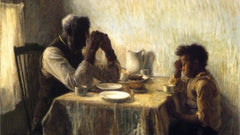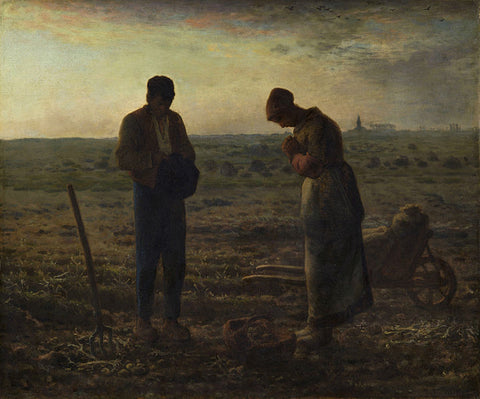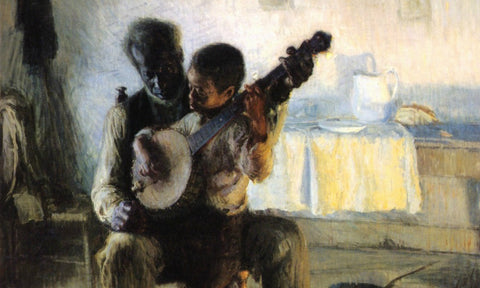
Meet The Masters: Henry Ossawa Tanner
Share
 Henry Ossawa Tanner was our first African-American distinguished painter to gain international recognition. Tanner was born on June 21, 1859, in Pittsburgh, Pennsylvania, to Benjamin Tucker and Sarah Miller Tanner. His father was an educated man and later would become a bishop of the African Methodist Episcopalian Church. His mother manage to escape the horrors of slavery by means of the Underground Railroad. In a time in America when slavery was still the norm, young Tanner was bitten by the art bug at the age of 13 by his fascination with the Philadelphia art galleries. However, wanting to be an artist was just unheard of, being it was hard enough just being African-Amercian in a racialist society.
Henry Ossawa Tanner was our first African-American distinguished painter to gain international recognition. Tanner was born on June 21, 1859, in Pittsburgh, Pennsylvania, to Benjamin Tucker and Sarah Miller Tanner. His father was an educated man and later would become a bishop of the African Methodist Episcopalian Church. His mother manage to escape the horrors of slavery by means of the Underground Railroad. In a time in America when slavery was still the norm, young Tanner was bitten by the art bug at the age of 13 by his fascination with the Philadelphia art galleries. However, wanting to be an artist was just unheard of, being it was hard enough just being African-Amercian in a racialist society.
Despite any setbacks, his mind was made up to become an artist. At the age of twenty-one, he enrolled in the prestigious Pennsylvania Academy of the Fine Arts. There he was able to study under a group of master professors. Thomas Cowperthwait Eakins would become one of Tanner’s greatest early influences. Thomas Eakins was a Pennsylvania native of English and Dutch descent that was an alumni and now a professor of the Pennsylvania Academy of the Fine Arts. Eakins was a Realist style painter that was heavily influenced by his time in Paris under the instruction of French Masters Jean-Leon Gerome and Leon Bonnat. Between the two masters, they have a super list of pupils: Charles Sprague Pearce, George Bridgman, Mary Cassatt, Henri de Toulouse-Lautrec, John Singer Sargent, Gustave Caillebotte, Paul Peel, Edvard Munch, Pierre Emmanuel Damoye and Walter Gay to name a few.

This steeped rich art history was being imprinted on the mind of young Tanner. Eakins suggested that Tanner go to France to farther his art career. When Tanner arrived in France there were a lot of artistic circles to choose from. Gustave Moreau had become the professor at the École des Beaux-Arts, Fauvist Henri Matisse was studying at the Académie Julian and became a student of William-Adolphe Bouguereau, Vincent van Gogh had just passed away and within six weeks his brother Theo van Gogh would organize his last exhibition and would pass away barely half a year later, Post Impressionist painter Paul Gauguin creates a copy of Olympia by Édouard Manet and French Impressionist Claude Monet creates his Haystacks series. Tanner wasting no time enrolled in the Académie Julian where he studied under Jean Paul Laurens and Jean Joseph Benjamin-Constant. At this time in his life, he would start to create some of the most important works depicting African-American subjects. A subject that many painters dabbled in but never committed to. Tanner would take the style and run with it creating works like the Thankful Poor, Spinning by Firelight, Bois d’Amour, The Bagpipe Lesson and The Bagpipe Player. He would first draw a series of studies sometimes from magazines like Harper’s Young People magazine, which he used to create The Banjo Lesson painting. Around 1895 Tanner painted Daniel in the Lion’s Den, which earned him an honorable mention in the Paris Salon. He was now going down a different path, the road of religious paintings and landscapes. The more he painted, the more the world noticed and rewarded him for it. He painted the Resurrection of Lazarus and it was purchased by the French government and exhibited at the Luxembourg Gallery, eventually it found a home in the Louvre collection. Henry Ossawa Tanner was now a fully international acclaimed artist in the eyes of the art world. The French called him Monsieur Tanner and treated him with respect and as a follow contemporary whenever they saw or wrote about him, while back home in America they called him a negro artist. Tanner would spend the rest of his life in France painting award-winning and influential artworks and will be forever known as the first African American international acclaimed artist.

The master realist oil painter Henry Ossawa Tanner died in Paris, France in 1937 leaving behind somewhere around 159 master artwork in private and museums collections all over the world as well as the spark of the African-Amercian style (later called Black Art) for many African-Amercian artists to adopt.